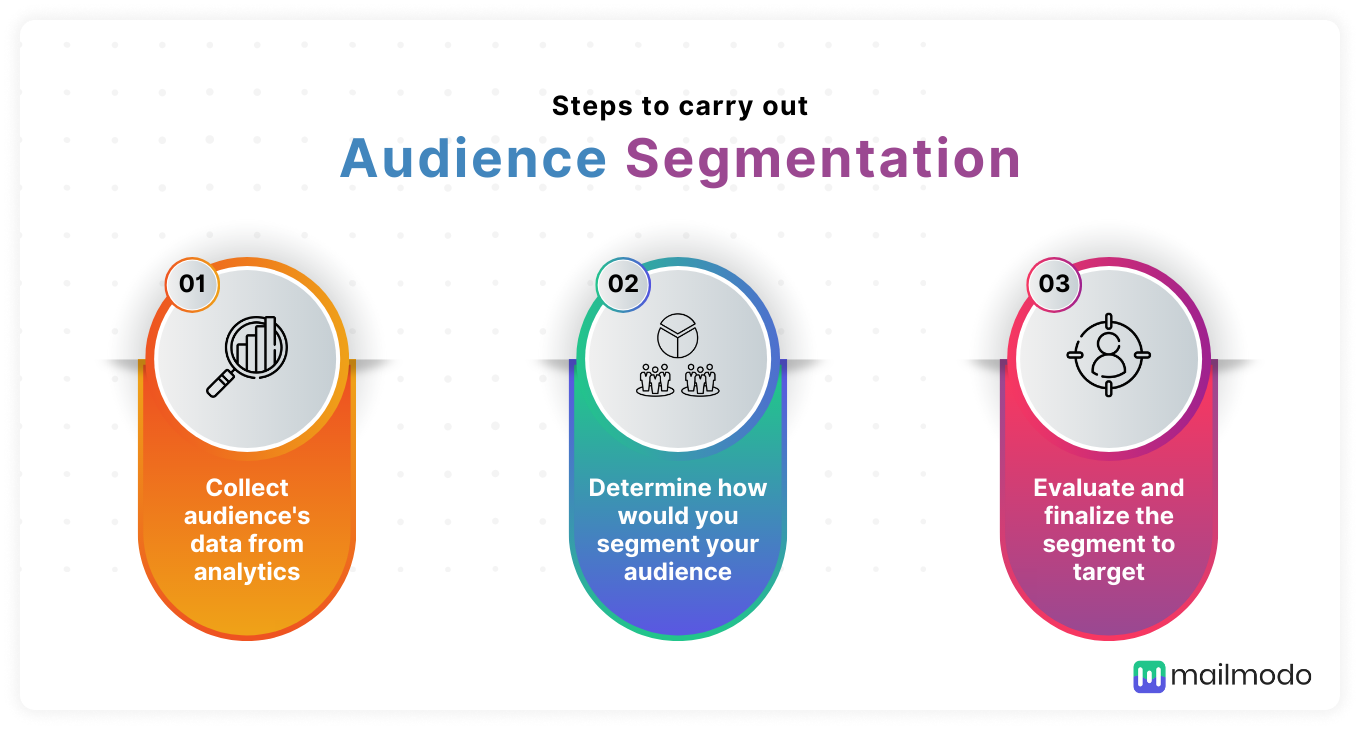Just like their fingerprints, every user is different. And if you send a similar email to all your users, what do you think will happen? Some might read it; some might delete it, or even worse, some might report it as spam. To avoid such problems, you should use audience segmentation in your email marketing strategy.
According to campaign monitor, segmented email marketing campaigns increase revenue by 760%. Thus, segmentation is crucial for your email campaign success, but you must thoroughly understand it. This article will help you understand the basics of audience segmentation, different criteria to segment, and steps to carry out segmentation.
Table of contents
What is audience segmentation?
Audience segmentation is a marketing strategy that divides your audience into subgroups based on their shared preferences, interests, demographics, etc. It helps build brand awareness, improve engagement level and boost your email marketing campaigns.
For example, you can create two different segments of your users - one segment includes users who open your email on mobile and others those who open it on desktops.
Why should you carry out audience segmentation?
Audience segmentation provides the following benefits to an organization:
✅ Better targeting
It makes targeting more convenient and easy. By segmentation, you can create a more specific audience having similar characteristics. In this way, you can target them with more relevant content.
✅ Higher conversions
The marketing team can customize and personalize the content according to the segments. Thus, the customers feel more valued, and they engage more with your content. This, in turn, will lead to more conversions and will also boost your email marketing ROI.
✅ Helps identify growth opportunities
With segmentation, you can better understand your audience’s problem, and use this information to explore areas where you can expand your marketing efforts. Doing so will help in identifying new development opportunities.
Two important aspects of audience segmentation
Before we talk about criteria to segment your audience, you should know about traits and attributes.
• Traits
Traits are pieces of information that are often inherent. For example, if we say a person is shy, then shyness is his/her personality trait.
• Attributes
When we talk about attributes, we consider a person’s behavior learned over a period of time. Unlike traits, attributes can change over time. Attributes provide information about how a person might react in a given situation.
Four criteria to segment your audience
You can segment your customers based on the following four criteria:
1. Demography
Demographic segmentation refers to the segment audience based on the structure of the population. You can create different segments based on the following demographic attributes:
You can segment your audience based on the following demographic aspects:
- Age
- Gender
- Family size
- Family life cycle
- Income
- Occupation
- Education
- Generation
- Ethnicity
- Nationality
- Religion
- Economic health
For example, Byjus, a leading Edtech startup, segments its audience based on age group and educational qualification. For example, one of their segments consists of children in 1-3 classes (4-6 years old). They have an app - Byju’s learning app, designed specifically for children in this age group. They target this audience by sending out emails and messages to their parents.
2. Geography
Geographic segmentation allows you to divide your audience based on where they live.
You can segment your audience using the following attributes:
- Continent
- Country
- State, city, town
- Neighborhood
- Pincode
- Timezone
- GPS location
- Seasonal changes
For instance, the e-commerce brand Amazon has different websites for different countries. It has amazon.in for India, amazon.ca for Canada, amazon.com for the USA, etc.
3. Psychography
Psychographic segmentation refers to grouping your audience based on attitudes, opinions, personal values, and other traits. Psychographics go beyond demography and geography.
For instance, Two people may have the same demographics: they may be in the same age group, live in the same city, and may use the same device, yet have different interests and lifestyles. For example, one could be interested in sports while the other likes to play video games.
Brands like IKEA, and Nike uses psychographic segmentation in the following way:
| Values | Interests |
|---|---|
| IKEA targets users who value and promote eco-friendly products using their sustainable strategy, “People and Planet Positive.” | Nike targets active individuals who take pleasure in sports, gym regularly, are athletes and are passionate about sports, which tend to be part of their life. |
4. Behavior
Behavioral segmentation refers to the criteria of segmenting audiences based on their plastic actions and activity. One of the models you can use to segment your audience is RFM model:
Recency - When was the last purchase they made/visited your website/opened your email?
Frequency - Numbers of purchases made by them/clicked on email?
Monetary - How much did they spend?
Besides, you can segment your audience based on their lifecycle stage. For example, you can look at whether a user is a - new user, repeated user, potential user, active user, ex-user, VIP user, etc.
Step-by-step process to carry out audience segmentation

Carrying out segmentation in the proper order is crucial. Following is the step-by-step guide to doing audience segmentation:
1. Collect audience’s data from analytics
Firstly, collect all the data about your audience from your analytics. This information is the foundation of your segmentation process. Some of the aspects you can look at are:
- Engagement level
- Purchase behavior
- Browsing activities
- Interests, value, lifestyle
- Platform with the highest traffic
- New user signup rate, etc.
For example, you may identify that 20% of new users between 18-30 who sign up for your newsletter have a low email engagement rate. In contrast, old users between the same age group have a 5% higher engagement rate on your email newsletter.
2. Determine how would you segment your audience
Here you should decide which criteria will be the most suitable to divide or segment the users. You can use any of the four ways discussed above to divide your audience. After you choose how you want to segment the audience, you can create different possible segments.
3. Evaluate and finalize the segment to target
For example, if you want to improve your newsletter’s engagement rate, but you target active users instead of inactive users. In that case, segmentation will not yield the results. Thus, it’s crucial to choose the right segment to target. M.A.S.D.A is criteria used by marketers to ensure that the segment they will target is beneficial for the marketing strategy. Here is what M.A.S.D.A mean:
| M.A.S.D.A. | What does it mean? |
|---|---|
| Measurable | |
| Accessible | |
| Substantial | |
| Differentiable | |
| Actionable |
Conclusion
Now that we have covered everything about audience segmentation, it’s your turn to put this into practice. But keep in mind, that segmentation takes time to generate desired results. Therefore, you must be patient throughout the process.
Using email marketing tools makes this process a lot easier and smooth. Tools like Mailmodo help you segment your audience most effectively and appropriately.
What you should do next
Hey there, thanks for reading till the end. Here are 3 ways we can help you grow your business:
Talk to an email expert. Need someone to take your email marketing to the next level? Mailmodo’s experts are here for you. Schedule a 30-minute email consultation. Don’t worry, it’s on the house. Book a meet here.
Send emails that bring higher conversions. Mailmodo is an ESP that helps you to create and send app-like interactive emails with forms, carts, calendars, games, and other widgets for higher conversions. Get started for free.
Get smarter with our email resources. Explore all our knowledge base here and learn about email marketing, marketing strategies, best practices, growth hacks, case studies, templates, and more. Access guides here.


